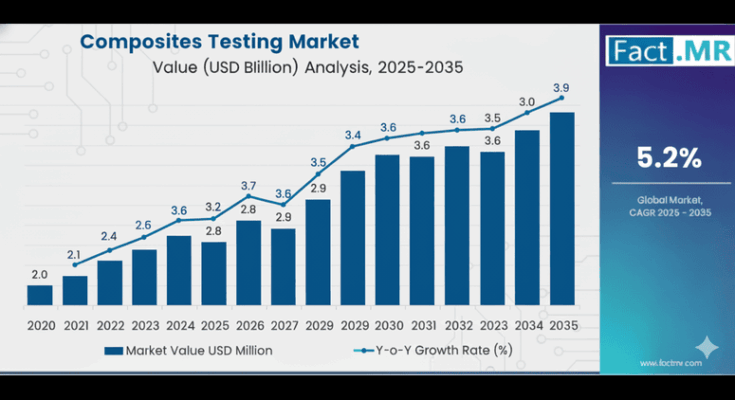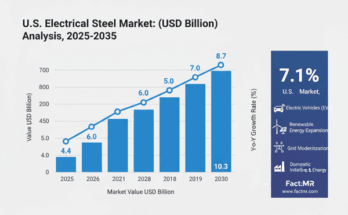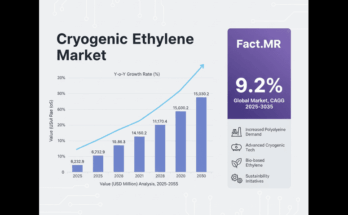The global composites testing market is projected to grow from USD 2.0 billion in 2025 to USD 3.9 billion by 2035, at a CAGR of 5.2%, according to Fact.MR. The growth is primarily driven by increasing utilization of lightweight and high-strength composite materials in aerospace, automotive, renewable energy, and construction industries. Technological innovations such as AI, digital twins, and non-destructive testing (NDT) are enhancing test efficiency, precision, and predictive capabilities.
Market Dynamics
-
Key Growth Drivers:
-
Rising adoption of composite materials in aerospace and automotive sectors to improve fuel efficiency, safety, and emissions compliance.
-
Expanding wind energy infrastructure driving turbine blade testing requirements.
-
Growing infrastructure and construction projects in emerging economies.
-
-
Technological Enablers:
-
Non-destructive testing techniques including ultrasonic, thermographic, and X-ray CT inspection.
-
Integration of AI and digital twins for predictive maintenance and real-time analytics.
-
Automation and cloud-based testing platforms enabling remote monitoring and data analytics.
-
-
Challenges:
-
High capital investment and operating costs of testing equipment.
-
Shortage of trained technicians and engineers, especially in developing markets.
-
Variability in international standards and cybersecurity concerns in digital testing platforms.
-
-
Opportunities:
-
Expansion of renewable energy and wind turbine manufacturing.
-
Digital transformation of test facilities and adoption of automated, AI-enabled platforms.
Market Segmentation
By Testing Method:
-
Destructive Testing: Poised to grow at 8.5% CAGR; critical for safety-critical industries like aerospace, automotive, and construction to determine mechanical performance under stress.
-
Non-Destructive Testing (NDT): Enables structural evaluation without damaging materials, increasingly favored for high-value composites.
By Product Type:
-
Ceramic Matrix Composites (CMCs): Expected to grow at 10.3% CAGR; high-temperature resistance and mechanical toughness make them ideal for defense, aerospace, and energy applications.
-
Polymer Matrix, Continuous, and Discontinuous Fiber Composites: Widely used in automotive, aerospace, and construction.
By End-Use Industry:
-
Aerospace & Defense: Largest demand driver due to safety-critical applications.
-
Transportation & Automotive: Focused on lightweighting, emissions reduction, and crash safety.
-
Wind Energy: Turbine blade testing and structural reliability.
-
Building & Construction: Urbanization, infrastructure projects, and green building initiatives.
-
Sporting Goods & Electricals: Niche applications with moderate growth.
By Region:
-
North America, Europe, Asia-Pacific, Latin America, Middle East & Africa.
Country-Level Insights (CAGR 2025–2035)
Country CAGR U.S. 5.5% UK 5.0% France 4.8% Germany 5.3% Italy 4.5% South Korea 5.6% Japan 5.2% China 6.0% Australia-New Zealand 4.7% Highlights:
-
U.S.: Aerospace, automotive, and defense sectors dominate; NDT adoption rising.
-
UK: Strong automotive and aerospace sectors; government sustainability initiatives support composites usage.
-
China: Rapid industrialization, EV manufacturing, and wind energy expansion drive demand.
-
Germany & Italy: Automotive and aerospace leaders leveraging composites for fuel efficiency and performance.
Competitive Landscape
Company Market Share (%) Key Offerings & Activities Element Materials Technology 18–22% Full-service destructive and NDT testing; global lab network; safety-critical materials testing. Exova Group 20–25% Acquired by Element; broad composites testing portfolio. Intertek Group 15–20% Advanced NDT, aerospace and automotive testing; international network. Mistras Group Inc. 12–15% NDT-focused; inspection solutions for defense, aerospace, and energy. Westmoreland Mechanical Testing & Research Inc. 5–7% Mechanical/destructive testing; high-precision aerospace applications. Other Notable Players: Matrix Composites, Instron, ETIM Laboratory, Henkel AG & Co. KGaA, Key Composites.
Strategic Trends:
-
Increased R&D investment in AI, automation, and digital twin platforms.
-
Expansion of global lab networks to meet rising regional demand.
-
Strategic collaborations with OEMs, regulators, and technology providers to enhance compliance and efficiency.
Market Outlook
Fact.MR forecasts steady growth through 2035, anchored by:
-
Adoption of high-performance composites across aerospace, automotive, and renewable energy sectors.
-
Digital transformation of testing processes using AI, machine learning, and automation.
-
Regulatory compliance and standardization efforts driving demand for reliable, high-precision testing.
-
Infrastructure development in emerging economies supporting widespread composites application.
Conclusion:
The composites testing market is entering a technology-driven phase, with AI-enabled NDT, digital twins, and predictive analytics redefining material validation. Companies that balance innovation, regulatory compliance, and cost efficiency are positioned to lead in this high-growth sector. -
-



